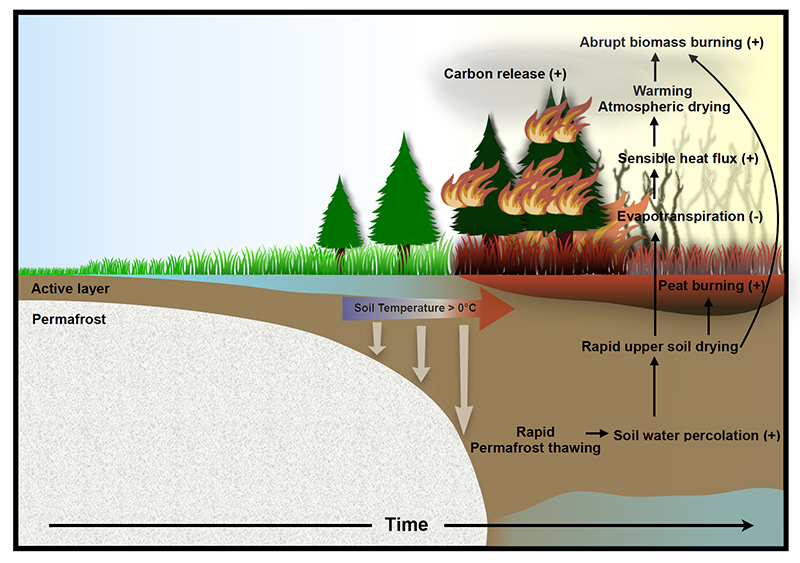Welcome to DU!
The truly grassroots left-of-center political community where regular people, not algorithms, drive the discussions and set the standards.
Join the community:
Create a free account
Support DU (and get rid of ads!):
Become a Star Member
Latest Breaking News
Editorials & Other Articles
General Discussion
The DU Lounge
All Forums
Issue Forums
Culture Forums
Alliance Forums
Region Forums
Support Forums
Help & Search
Environment & Energy
Related: About this forumInstitute for Basic Science: Abrupt intensification of northern wildfires due to future permafrost thawing
https://ibs.re.kr/cop/bbs/BBSMSTR_000000000738/selectBoardArticle.do?nttId=25037&pageIndex=1&searchCnd=&searchWrd=Abrupt intensification of northern wildfires due to future permafrost thawing
A study, published in the journal Nature Communications by an international team of climate scientists and permafrost experts shows that, according to new climate computer model simulations, global warming will accelerate permafrost thawing and as a result lead to an abrupt intensification of wildfires in the Subarctic and Arctic regions of northern Canada and Siberia.
Recent observational trends suggest that warm and unusually dry conditions have already intensified wildfires in the Arctic region. To understand and simulate how future anthropogenic warming will affect wildfire occurrences, it is important to consider the role of accelerated permafrost thawing, because it strongly controls the water content of the soil – a key factor in wildfire burning. Recent climate models did not fully consider the interaction between global warming, northern high latitude permafrost thawing, soil water and fires.
The new study uses permafrost and wildfire data generated by one of the most comprehensive earth system models – the Community Earth System Model. It is the first model of its kind, which captures the coupling between soil water, permafrost and wildfires in an integrated way. To better separate the anthropogenic effect of increasing greenhouse gas emissions from naturally occurring variations in climate, the scientists used an ensemble of 50 past-tofuture simulations covering the period from 1850-2100 CE (SSP3-7.0 greenhouse gas emission scenario), which was recently conducted by scientists from the IBS Center for Climate Physics, Busan (South Korea) and the National Center for Atmospheric Research in Boulder, Colorado (United States) on the IBS supercomputer Aleph.
With this ensemble modelling approach, the team demonstrated that by the mid to late 21st century anthropogenic permafrost thawing in the Subarctic and Arctic regions will be quite extensive. In many areas, the excess soil water can drain quickly, which leads to a sudden drop in soil moisture, subsequent surface warming and atmospheric drying (Figure 1). “These conditions will intensify wildfires,” says Dr. In-Won Kim, lead author of the study and postdoctoral researcher at the IBS Center for Climate Physics in Busan, South Korea. “In the second half of this century, our model simulations show an abrupt switch from virtually no fires to very intensive fires within just a few years” she adds.
…

Figure 1. ARABIC 1. Schematic illustration showing the intensification of wildfires due to rapid permafrost thawing in a warmer climate. / Figure credit by In-Won Kim
…
http://dx.doi.org/10.1038/s41467-024-51471-xA study, published in the journal Nature Communications by an international team of climate scientists and permafrost experts shows that, according to new climate computer model simulations, global warming will accelerate permafrost thawing and as a result lead to an abrupt intensification of wildfires in the Subarctic and Arctic regions of northern Canada and Siberia.
Recent observational trends suggest that warm and unusually dry conditions have already intensified wildfires in the Arctic region. To understand and simulate how future anthropogenic warming will affect wildfire occurrences, it is important to consider the role of accelerated permafrost thawing, because it strongly controls the water content of the soil – a key factor in wildfire burning. Recent climate models did not fully consider the interaction between global warming, northern high latitude permafrost thawing, soil water and fires.
The new study uses permafrost and wildfire data generated by one of the most comprehensive earth system models – the Community Earth System Model. It is the first model of its kind, which captures the coupling between soil water, permafrost and wildfires in an integrated way. To better separate the anthropogenic effect of increasing greenhouse gas emissions from naturally occurring variations in climate, the scientists used an ensemble of 50 past-tofuture simulations covering the period from 1850-2100 CE (SSP3-7.0 greenhouse gas emission scenario), which was recently conducted by scientists from the IBS Center for Climate Physics, Busan (South Korea) and the National Center for Atmospheric Research in Boulder, Colorado (United States) on the IBS supercomputer Aleph.
With this ensemble modelling approach, the team demonstrated that by the mid to late 21st century anthropogenic permafrost thawing in the Subarctic and Arctic regions will be quite extensive. In many areas, the excess soil water can drain quickly, which leads to a sudden drop in soil moisture, subsequent surface warming and atmospheric drying (Figure 1). “These conditions will intensify wildfires,” says Dr. In-Won Kim, lead author of the study and postdoctoral researcher at the IBS Center for Climate Physics in Busan, South Korea. “In the second half of this century, our model simulations show an abrupt switch from virtually no fires to very intensive fires within just a few years” she adds.
…

Figure 1. ARABIC 1. Schematic illustration showing the intensification of wildfires due to rapid permafrost thawing in a warmer climate. / Figure credit by In-Won Kim
…
2 replies
 = new reply since forum marked as read
Highlight:
NoneDon't highlight anything
5 newestHighlight 5 most recent replies
= new reply since forum marked as read
Highlight:
NoneDon't highlight anything
5 newestHighlight 5 most recent replies
Institute for Basic Science: Abrupt intensification of northern wildfires due to future permafrost thawing (Original Post)
OKIsItJustMe
Sep 2024
OP
Clouds Passing
(6,962 posts)1. Sad...
SamKnause
(14,680 posts)2. Feed back loops have been activated.
There are many more to come.